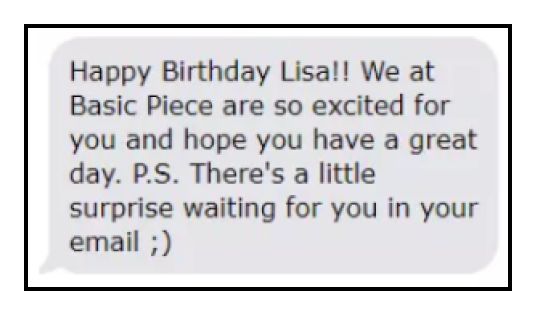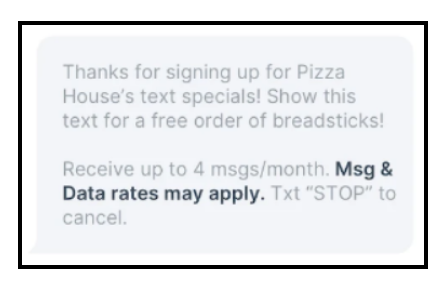REDCON1 counts their SMS channel as one of their most profitable channels; it has the highest ROAS (return on ad spend). Even though they frequently share discounts, REDCON1’s unsubscribe rate is low, and campaign conversion rates range from 8% to 26%.

Redcon1 is just one of the many ecommerce brands that have recognized the value of SMS marketing.
Their route to SMS is not exclusive. Typically, the standard growth marketing playbook begins with a brand identifying its primary sales channel (DTC, through intermediaries, B2B, or wholesale). Typically, the business then chooses which marketing channels to employ.
These channels for DTC brands may include social media, email, newsletters, and partnerships.
After testing and implementing a few channels, they will begin searching for the next frontier. SMS marketing, which allows brands to communicate with their customers via text messages, typically comes into play here.
It’s no secret that people don’t always check their email daily, let alone the cumbersome “promotions” folder. And iOS updates and a cookie-less world in the future make owned marketing even more essential.
SMS opens up an entirely new world of owned marketing for DTC brands:
- The average customer checks their smartphone 96 times per day. That’s a lot of opportunities to reach your customers’ minds.
- The average SMS open rate is 99% whereas the average email open rate is less than 20%.
- SMS text message marketing has a 45% response rate, while email response rates hover around 6%.
- 91% of customers would opt-in for text messages from brands.
- 34% of people read their messages within five minutes of receiving them.
- 58% of customers believe that SMS is the most effective way for brand communication.
- 96% of marketers using text messages said it helped them drive revenue.
There is no one-size-fits-all approach to SMS marketing—and there shouldn’t be, given that every brand and customer base is unique.
Adding to the tips covered in our earlier blog, here are seven SMS marketing best practices that will help your brand be customer-first and grow:
1) Send SMSes from a simple, memorable short code
With shared short codes being phased out, there are two methods of sending SMS messages available now:
- With a 5 or 6-digit dedicated SMS short code
- Having a 10-character code
You should view the elimination of shared short codes as a hidden boon. Instead of sharing your short code with another brand, you can now build a truly personalized, branded relationship with your customers. The short code has the same influence as an instantly recognizable “send-from” name in an email inbox, resulting in increased engagement potential.
Remember this!
With long codes, only one message per second can be transmitted. Also, long codes are incompatible with MMS.
In addition, when a customer receives a text message from a short code, they immediately recognize that it was sent by a brand. While a long code simulates the experience of texting with another person, people don’t mind receiving text messages from short codes.
Carriers manually approve all short codes, so using a short code reduces the likelihood of being filtered or suspended by carriers.
There are specific situations in which a long code is preferable for your promotional text messages, such as when you truly require a one-on-one communication channel or when you only anticipate sending a small number of messages. Typically, however, the best option is a short code.
To reap the benefits of SMS marketing, you must have as many people as possible sign up for your SMS program. Start by promoting your short code. For instance, you could run a contest that requires an opt-in via SMS. Share this giveaway with your email list and/or followers on social media.
For example, Chipotle sent the following email campaign to students on its email list. Students were required to text its short code to be eligible to win a gift card:

When students texted “DORM2” to 888222, to enter the SMS giveaway, they received the following text message response, asking them to respond YES to confirm that they were a student at a participating college:

2) Include SMS marketing in omnichannel campaigns
Omnichannel marketing campaigns enable you to send precisely timed, intelligent messages across multiple channels. Perfectly coordinating each message is essential for a successful marketing campaign.
For instance, let’s say a customer opens a well-crafted and designed email containing images of a new product line, and 30 minutes later, just as they’re contemplating a purchase, they receive an SMS with a discount code. It is a foolproof method for increasing conversions.
You should use marketing automation software that enables you to combine multiple channels to perfectly time the interval between the first and second messages sent to a customer. You can “trigger” the second message to be sent after the first message has been opened or clicked, ensuring a consistent campaign flow and an optimal response rate. For instance, for abandoned cart campaigns, you schedule an automated SMS to be sent as soon as a cart is abandoned, and if not converted, then schedule a cart recovery email to be sent out a few hours later.
Of course, you should determine which medium is most effective for each customer and communicate with them via their preferred channel.
You should also use fallback logic to generate dynamic omnichannel workflows. For instance, if a customer does not receive or open an SMS, automatically attempt to contact them via email or Facebook Messenger:

3) Personalize SMSes via segmentation and send times
A modern SMS marketing solution will allow you to segment your contacts and customers and therefore target them in the same way that many email marketers do.
Use the information you already have on your customers, such as their purchase or browsing history, demographics, and interests, to create targeted contact segments. Then, personalize your SMS campaigns to each segment for maximum results!
Personalize the text content. There is an abundance of customer data you can use to make your texts feel more human and individualized. For instance, send relevant messages based on the customer’s location, previous purchases, and product affinity to build and maintain relationships with them.
On significant events such as their birthday or one-year anniversary, you can include a personalized offer directly in the SMS message:

Or use the SMS as a teaser to encourage the customer to check their email for a special gift:

Personalize send times. Not all customers have the same sleeping schedule. With a bit of experimentation, you will learn the different segment-specific habits of your customers. Use this information to optimize the send times of your text messages, so customers receive them at the optimal time for engagement (based on their time zones).
Sending irrelevant or poorly-timed messages can have a negative impact on your campaign objectives and lead to higher opt-out rates and a damaged brand reputation.
4) Keep messages crisp and clear
The average attention span is diminishing. A study revealed that the average human attention span is 8.25 seconds. When sending text messages, it is vitally important to keep them brief and concise, ideally in the range of 160 characters or less. So don’t digress.
Here are some suggestions for shaping your message:
- Consider the value: Before sending any SMS campaign, ask yourself: How will this SMS text message add value to my customer’s life? Ensure that every sent text contains valuable information. People have granted you permission to communicate with them through a highly intimate channel. Make it worth their while.
Keep your messages fresh and engaging. They should be treated as VIPs. If you do not provide customers with something of value each time you send a text, it is likely that they will unsubscribe.

- Introduce yourself: Your recipients should recognize you immediately. Otherwise, the recipient will not comprehend the context of your message. This is fundamental brand marketing material.

- Use proper grammar: Text slang and abbreviations are not understood by everyone, so avoid using them. Your brand will appear unprofessional if you use unnecessary abbreviations, text speak, and incorrect capitalization.Text slang and abbreviations are not understood by everyone, so avoid using them. Your brand will appear unprofessional if you use unnecessary abbreviations, text speak, and incorrect capitalization. Make sure to proofread your text thoroughly, and for this purpose, you can use an online grammar checker. Such a tool highlights all kinds of mistakes existing in the content and provides suggestions to rectify them on the go.
If you must save characters by shortening some of your words, begin with the most common text abbreviations and limit their use as much as possible. For example, “ICYMI: Sitewide sale this weekend only. Use the checkout code WEEKOFF for an additional 20% off. [Link to site]”
5) Add disclaimers, wherever applicable
CTIA is a non-profit international trade association that represents the wireless communications industry. They are the source of many SMS marketing best practices and also govern the majority of texting via short codes.
Initial opt-in language must include the phrase “Message and data rates may apply.” This disclaimer merely informs subscribers that enrolling in your SMS program and receiving future messages will count against their text/data allowances:

Also, you should include important T&Cs, especially in promotional SMSes whenever and as frequently as necessary:

6) Include only one CTA; make it powerful
According to Omnisend, approximately one-third of SMS recipients respond to the CTA (Call to Action), and 47% of this engaged group will make a purchase.
In addition to being a great SMS marketing best practice, including a CTA is one of the most fundamental marketing best practices. Always include a CTA at the end of your SMS marketing messages:
- Subscribe through <link> to receive Christmas offers
- Use <code> at checkout before <date> for free shipping
- Answer our survey <link> to win assured prizes!
- Visit <link> by <date> for sitewide sale at 40% off before they’re gone!
What is the next logical step for your customers? Point them in the proper direction:

7) Allow customers to opt-out
Customers should always have the option to opt-out of your SMS program. Each text message must include an opt-out option. Permit them to respond with a “STOP” text message or, if sending to a recipient outside the United States or Canada, provide a link to unsubscribe.

All mass texting services process special “opt-out keywords” that immediately unsubscribe customers, who reply with these terms: STOP, UNSUBSCRIBE, END, and CANCEL.
Have a purpose behind each SMS
Don’t send text messages just for the sake of sending them. As with any other marketing strategy, SMS marketing is most effective when clear goals and objectives are established.
Each and every text message you send should have a specific objective. Consider the action you want your customer to take after reading your message:
- Do you wish them to visit a particular product page?
- Browse your new collection of hats?
- Write a product review?
- Refer a friend to get additional discounts or VIP membership?
- Buy a product that is available at a time-sensitive discount?
When you have a goal in mind, you can write better copy, include a compelling CTA, and keep things concise and clear. You will also be able to monitor the efficacy of your SMS campaigns to determine whether or not they helped you achieve your objectives.
You may also like
Essential resources for your success
























































